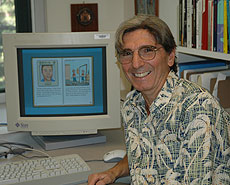SANTA CRUZ, CA--Tools developed by researchers exploring language and speech comprehension can become powerful aids for remedial readers, children with language challenges, and anyone learning a second language, according to psychology professor Dominic Massaro of the University of California, Santa Cruz.
Massaro is a cognitive researcher whose breakthroughs have advanced the understanding of the importance of face-to-face interaction in speech comprehension. Massaro will participate in a panel discussion of advances in language and speech science at the annual meeting of the American Association for the Advancement of Science (AAAS) in Boston.
Massaro has developed computer-assisted speech and language tutors that use natural human speech to model language articulation. This sophisticated technology, which has helped autistic and hearing-impaired children, is now being incorporated into a soon-to-be-released reading intervention program from Scholastic, and the software is being tailored to help with the acquisition of languages, including Arabic.
"When you're learning a new language, it's helpful to see how the words are formed," said Massaro. "For instance, in Arabic, segments are articulated at the back of the throat." Massaro's facial animation software features a realistic tongue and palate that students can access in dynamic sideview cutaways of the tongue, jaw, and teeth. Combining such visual cues with sound boosts comprehension--and mimics the natural processes that laboratory experiments by Massaro and others have illuminated.
"People often have difficulty pronouncing and discriminating certain sounds in foreign languages," said W. Lewis Johnson, CEO of Alelo, an interactive computer gaming startup that uses speech recognition to teach foreign languages to players in simulated environments like Iraq. "Baldi (Massaro's animated tutor) is a potentially useful tool for helping language learners to overcome these difficulties."
During a recent presentation at the Defense Language Institute in Monterey, California, Massaro emphasized the value of an animated tutor in second-language acquisition. "Working with Baldi can be less intimidating because students don't feel shy about making mistakes," he said, adding that students can practice outside the classroom and get feedback when teachers are unavailable.
"The ability to perceive speech is based on the integration of visual and auditory information," said Massaro, whose Animated Speech Corporation (ASC) has produced software that features an animated tutor that teaches vocabulary, grammar, pronunciation, and speech articulation. The software is in use by hard-of-hearing students at the Tucker-Maxon Oral School in Portland, Oregon, and the Bay School for autistic children in Santa Cruz.
#####
Editor's Note: The AAAS panel discussion, "Advances in Language and Speech Science and Technology," will take place on Friday, February 15, from 8:30 to 10 a.m. Massaro also gave a presentation entitled "Embodied Conversational Agents with Realistic Speech and Language" during a news briefing on Thursday, February 14. He can be reached at massaro@fuzzy.ucsc.edu.



